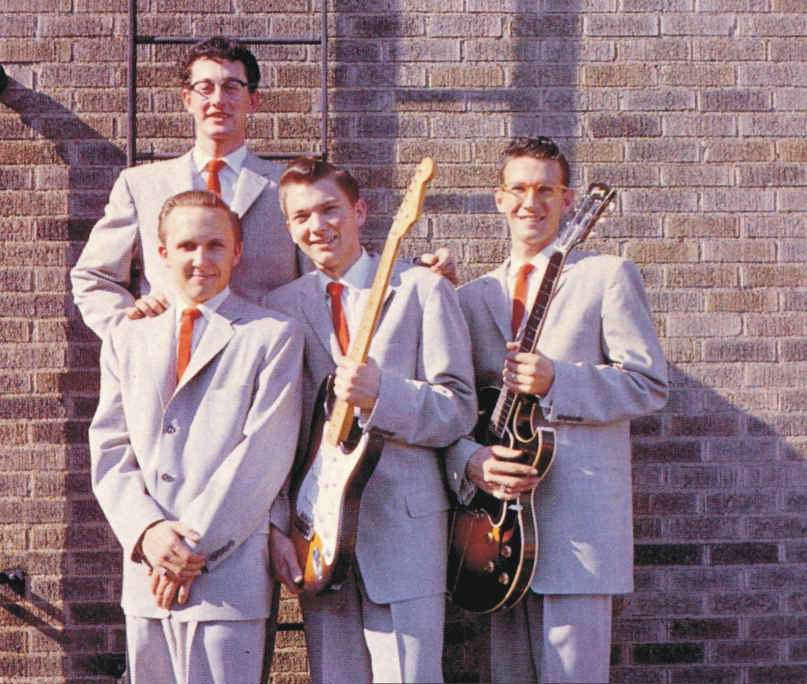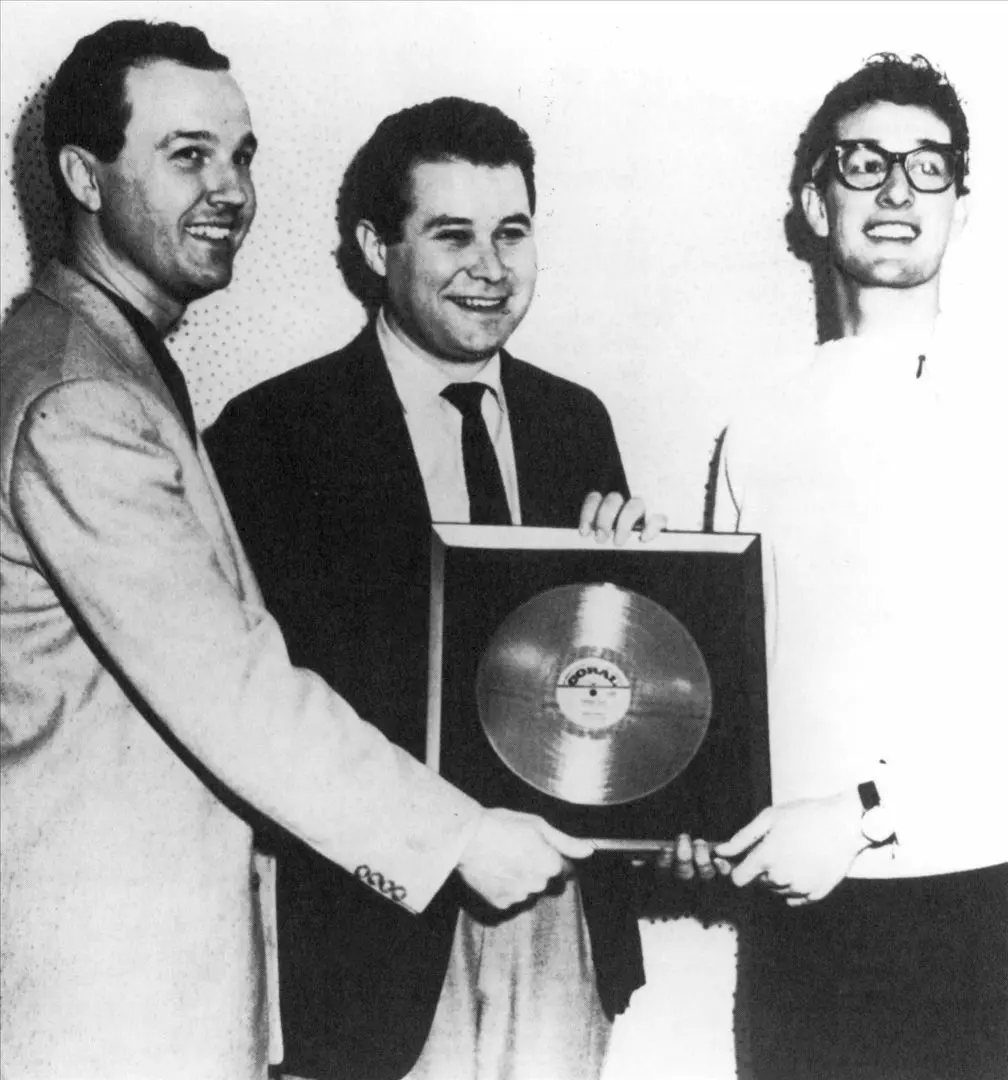Buddy Holly – The Pioneer of Rock ‘n Roll

Photo source: Getty Images
It's hard to believe that it's been over sixty years since the world lost one of its most extraordinary musical talents in a tragic plane crash. Buddy Holly, the "Peggy Sue" hitmaker, was taken from us far too soon, leaving behind an incredible legacy of timeless music that still resonates with fans today.
Buddy Holly Bio
Born Charles Hardin Holley in 1936, Buddy Holly grew up in Lubbock, Texas, where he was first introduced to music by his family. He began playing the guitar and singing at a young age and quickly developed a passion for creating his original songs. In 1955, Buddy and his band, The Crickets, recorded their first hit single, "That'll Be the Day," which became a chart-topping success.
The Buddy Holly Difference
His innovative approach to songwriting and his unique sound set Buddy Holly apart from other musicians of his time. He was one of the first artists to experiment with recording techniques, incorporating double-tracking and other effects to create a layered, full-bodied sound ahead of its time. His music was a mix of rock and roll, country, rhythm, and blues, and he had a natural talent for crafting catchy hooks and memorable lyrics.
Buddy Holly - Heartbeat: the last song released before his death.
The Day The Music Died - Buddy Holly's Death
Sadly, Buddy Holly's life was cut short in 1959 when he and fellow musicians Ritchie Valens and J.P. "The Big Bopper" Richardson were killed in a plane crash while on tour. The tragedy shook the music world and left fans devastated as they mourned the loss of one of his generation's most talented and innovative artists.
The Legend of Buddy Holly
Despite the heartbreaking end to Buddy Holly's life, his music continues to inspire and influence musicians to this day. Countless artists have covered his songs, and his legacy lives on through the Rock and Roll Hall of Fame, which inducted him in 1986. From "Everyday" to "True Love Ways," Buddy Holly's music remains a testament to his talent and creativity and a reminder of his profound impact on the music world.
As a creative professional, I can't help but be inspired by the life and work of Buddy Holly. His passion, innovation, and dedication to his craft serve as a reminder that true greatness comes not just from talent but from hard work, determination, and a willingness to take risks. Buddy Holly may be gone, but his music lives on, a testament to his enduring legacy and impact on the music world.

Photo Source: telegraph.co.uk
Buddy Holly's Influence on Rock and Roll
Here are a few ways in which Buddy Holly's influence can be seen in modern rock singers and songwriters:
- Melodic Songwriting: Buddy Holly was known for his ability to craft melodic and memorable songs. Many modern rock singers and songwriters draw inspiration from his approach to songwriting, focusing on strong melodies and catchy hooks in their own compositions.
- Vocal Style: Buddy Holly's clear and expressive vocal style left a lasting impression. His influence can be heard in the vocal delivery of numerous rock singers who appreciate his emotive singing and phrasing.
- Storytelling in Lyrics: Holly's songs often told stories and conveyed relatable emotions. This narrative approach to songwriting has influenced modern rock singers who use storytelling as a key element in their lyrics.
- Cross-Genre Appeal: Buddy Holly's music had a broad appeal, bridging the gap between rock and roll, country, and pop. Modern rock singers often explore a range of influences and genres, reflecting Holly's versatility.
- Guitar-Driven Music: While primarily known as a singer and songwriter, Buddy Holly's guitar work also left an impact. Modern rock singers who play guitar may incorporate elements of his guitar style into their own music.
- Live Performances: Holly's energetic and engaging live performances set a precedent for modern rock singers in terms of stage presence and connecting with audiences.

Photo Source: tuacahn.org
The Buddy Holly Influence on "The Gods of Rock"
Eddie Van Halen, the renowned guitarist and co-founder of the rock band Van Halen, once commented on Buddy Holly in an interview. He mentioned that Buddy Holly's music and guitar playing significantly impacted him. Eddie Van Halen credited Buddy Holly as one of the early influences that inspired him to pick up the guitar and start playing music.
George Harrison: As a member of The Beatles, George Harrison was deeply influenced by Buddy Holly's music. The Beatles covered several Buddy Holly songs, and Holly's simple and melodic style influenced Harrison's early guitar playing.
Eric Clapton: The legendary blues-rock guitarist Eric Clapton has mentioned Buddy Holly as one of his early influences. Holly's music played a role in shaping Clapton's approach to guitar playing and songwriting.
Keith Richards: The Rolling Stones' Keith Richards cited Buddy Holly as influencing his guitar playing and songwriting. The Stones recorded a version of Holly's "Not Fade Away."
Pete Townshend: The Who's Pete Townshend has acknowledged Buddy Holly's influence on his guitar work and songwriting. Townshend's use of power chords and aggressive strumming can be traced back to the early rock and roll style popularized by Holly.
Bruce Springsteen: Bruce Springsteen, known for his energetic live performances and songwriting, has mentioned Buddy Holly as an influence on his music. Holly's ability to write catchy, narrative-driven songs resonated with Springsteen's approach.

Photo Source: strathdee.wordpress.com
Buddy Holly References in Pop Culture
Here are a few notable pop culture references that contain Buddy Holly:
- "The Buddy Holly Story" (1978): This biographical film starring Gary Busey as Buddy Holly explores the life and career of the rock and roll legend. It contributed to the enduring image of Buddy Holly in popular culture.
- "Weezer (The Blue Album)" by Weezer: The cover art of Weezer's 1994 self-titled debut album, often referred to as "The Blue Album," features a picture of the band members dressed in sweaters and ties, which is reminiscent of Buddy Holly's style. The album also includes the hit song "Buddy Holly."
- "American Graffiti" (1973): While not specifically about Buddy Holly, this classic coming-of-age film set in the early 1960s features a scene where the characters hear about Buddy Holly's death on the radio. It highlights the impact of his music on the youth culture of the time.
- "Pulp Fiction" (1994): In Quentin Tarantino's film "Pulp Fiction," the character Jules, played by Samuel L. Jackson, quotes the line, "You know what they call a Quarter Pounder with Cheese in Paris?... They call it a 'Royale with Cheese.'" He goes on to mention Buddy Holly while discussing pop culture.
- "American Pie" by Don McLean: Don McLean's iconic song "American Pie" contains the famous line "the day the music died," which refers to the tragic plane crash that claimed the lives of Buddy Holly, Ritchie Valens, and J.P. "The Big Bopper" Richardson in 1959.
- "Peggy Sue Got Married" (1986): In this film, directed by Francis Ford Coppola, Kathleen Turner plays the title character, Peggy Sue, who travels back in time to her high school years. There's a memorable scene where she meets Buddy Holly before he becomes famous.
- "La Bamba" (1987): The biographical film "La Bamba," which tells the story of Ritchie Valens, prominently features Buddy Holly and the events leading up to the plane crash in Clear Lake, Iowa.
- "The Wonder Years": This coming-of-age series set in the 1960s and early 1970s featured episodes referencing Buddy Holly and his music, reflecting the show's nostalgia for the period.
- "The Simpsons": In the episode "Love, Springfieldian Style," Homer and Marge Simpson attend a Buddy Holly-themed dance at their high school reunion.
- "The Goldbergs": Set in the 1980s but with a strong appreciation for 1980s pop culture, "The Goldbergs" has referenced Buddy Holly and his music in several episodes.
- "Gilmore Girls": In one episode of "Gilmore Girls," Luke and Lorelai attend a karaoke night, and Luke performs Buddy Holly's song "Oh, Boy!"
- "That '70s Show": While the show is set in the 1970s, it often references the music and culture of the 1950s and 1960s, which includes nods to Buddy Holly.
- "Happy Days": The TV series "Happy Days" occasionally featured references to Buddy Holly and his music, as the show was set in the 1950s and celebrated the era's pop culture.
- "Back to the Future" (1985): While not primarily focused on Buddy Holly, the film features a humorous reference to him. In one scene, Marty McFly, played by Michael J. Fox, introduces the song "Johnny B. Goode" at a high school dance by saying, "This is a blues riff in 'B,' watch me for the changes, and try to keep up," a nod to Buddy Holly's influence on rock and roll.
- Literature: Buddy Holly's music and legacy have been referenced in various books, including novels, biographies, and music histories, as he played a pivotal role in the evolution of rock and roll.

Photo Source: iheart.com
These references showcase Buddy Holly's lasting influence and significance in entertainment and popular culture. His contributions to music and style continue to be celebrated and remembered.
The Buddy Holly Interview to Remember
Paul Colburn conducted one of the most famous interviews with Buddy Holly for the "KLLL Pop Shop" radio show in Lubbock, Texas, on October 18, 1958. This interview is notable not only for its content but also because it is one of the last known interviews with Buddy Holly before his tragic death in a plane crash on February 3, 1959.
Holly discusses various aspects of his career in this interview, including his music, songwriting, and plans. He talks about his influences, his desire to continue evolving as an artist, and his experiences in the music industry.
The interview provides valuable insights into Buddy Holly's thoughts and aspirations at a critical juncture in his career. It captures his enthusiasm for music and the evolving rock and roll scene of the late 1950s. Tragically, Holly's life was cut short just a few months later, but his music and interviews like this one continue to be treasured by fans and historians as a glimpse into his life and creative process.

Photo source: bestclassicbands.com